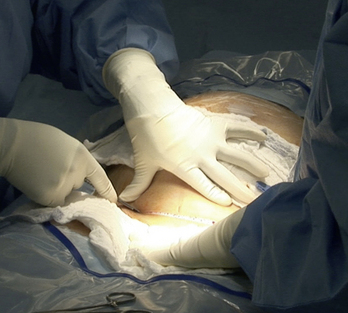Chapter 19 Cesarean Section
Key steps
The incision size should be adjusted based on the patient’s habitus and estimated fetal size. Incise the skin and subcutaneous fat down to the fascia. Expect to encounter the inferior epigastric arteries and veins along the lateral aspects of the incision line. These can be either clamped or cauterized for hemostasis. Open the fascia adjacent to the midline linea alba. Incise the fascia down to the rectus muscle, then use Metzenbaum or curved Mayo scissors to bluntly track laterally along the incision path, separating the fascia off the rectus muscle. The scissors are then used to extend the initial fascia incisions laterally, approximating 10 cm in each direction (Figure 19-3). The assistant should use a small retractor to provide lateral exposure for the surgeon to create an adequate fascia incision. When the fascia is opened, it is manually dissected superiorly and inferiorly off the rectus. The linea alba will remain attached at the midline. Clamp the fascia with Kocher clamps and lift the fascia off the rectus, providing counter-traction against the linea alba. Using heavy Mayo scissors, cut the linea alba free, both superiorly and inferiorly from the rectus muscle. Take care not to button-hole the fascia when releasing it from the linea alba (Figure 19-4).
Stay updated, free articles. Join our Telegram channel

Full access? Get Clinical Tree




